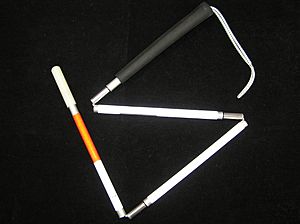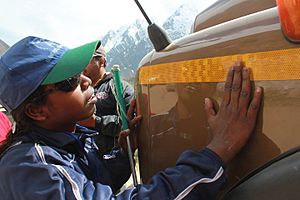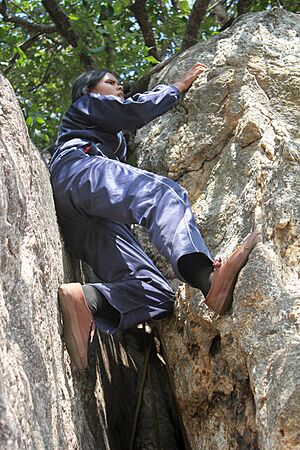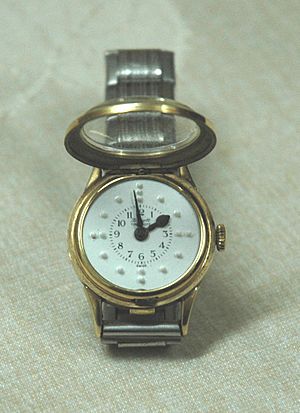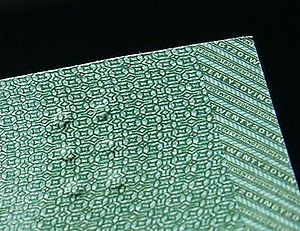Blindness facts for kids

Blindness means you cannot see anything at all. Sometimes, people are called blind even if they can see a little bit. This usually means their vision is very blurry, and they can only see shapes or colors, not clear details.
In many modern countries, very few young people are blind. Around the world, blindness often happens because of poor nutrition or diseases that affect older people, like cataracts. People can become blind from diseases or accidents, but some are born blind.
Some people are color blind. This means they can see, but they have trouble telling certain colors apart.
When people are blind, they use special tools and methods to do everyday things. These include the alphabet called braille and trained guide dogs.
Many famous people have been blind, such as Louis Braille, who invented the braille alphabet, and musicians like Stevie Wonder and Ray Charles. Helen Keller was also a famous blind and deaf author and activist.
Contents
What is Blindness?
Doctors define vision problems as reduced vision that cannot be fully fixed with glasses or contact lenses. The World Health Organization (WHO) has different levels of vision problems:
- Mild vision loss: This is when vision is almost normal.
- Moderate vision problems: This means vision is quite blurry.
- Severe vision problems: This is when vision is very blurry.
- Profound vision problems: This means vision is extremely blurry.
- Near-total blindness: People can barely see anything.
- Total blindness: People cannot see any light at all.
How Blind People Live and Learn
Many organizations offer help, education, and support for blind people. They help them learn new skills and join in with work and social life.
Getting Around (Mobility)
Many people with serious vision problems can travel on their own. They use different tools and methods. Special teachers called "orientation and mobility specialists" help blind people learn to travel safely and confidently. These teachers can also help blind people practice routes they use often, like going from home to a store. Knowing a place well makes it much easier to get around.
One common tool is the white cane with a red tip. This is an international symbol of blindness. A long cane helps the user feel what is ahead. It is usually swung side-to-side to find obstacles. There are different ways to use a cane, depending on the person and the situation. Some people use shorter, lighter canes just for others to know they have a vision problem.
A small number of people use guide dogs to help them move around. These dogs are trained to walk around obstacles and show when there are steps. However, dogs cannot understand complicated directions. The person with the guide dog must know where they want to go, and the dog helps them get there safely.
GPS devices can also help blind people find their way. These devices can help with directions, but they don't replace canes or guide dogs.
Some blind people can use human echolocation. This means they make clicking sounds with their mouth and listen to the echoes. This helps them figure out where objects are. Studies show that blind people who are good at echolocation use the part of their brain normally used for seeing to process these echoes.
Governments sometimes make public places easier for blind people to use. Public transport is often free for blind people in many cities. Special bumpy paths on sidewalks (called Tactile paving) and traffic signals that make sounds can make crossing streets safer. Some laws also say that drivers must give the right-of-way to people using white canes or guide dogs.
Reading and Learning
Most people with vision problems who are not totally blind can still read print. They might use magnifying glasses or other devices to make the text bigger. Many also read large-print books, which are easier to see without special tools.
Others read Braille, which is a system of raised dots felt with the fingers. They might also listen to talking books or use machines that turn printed text into speech or Braille. Computers with special programs like screen readers and refreshable Braille displays are also very helpful.
Libraries and organizations for the blind, like the National Library Service for the Blind and Physically Handicapped in the United States, provide these materials.
Closed-circuit televisions (CCTVs) are high-tech tools that enlarge text and change its contrast. This makes reading much easier for people with low vision.
There are also many radio reading services around the world. These services read newspapers and magazines aloud over the radio for people with vision problems.
Using Computers
Special tools like screen readers, screen magnifiers, and refreshable Braille displays help blind people use computers and mobile phones. More and more technology is being made to be accessible for everyone, including blind people. For example, newer versions of Microsoft Windows have built-in tools like Magnifier and Narrator. Mac OS has a screen reader called VoiceOver.
The effort to make websites more accessible (called web accessibility) means that more websites can be used by blind people with their special tools.
Scientists are also working on new ways to help blind people "see" using cameras and other senses.
Computers can also show text in very large print or with simple, clear pictures. This helps users who can still see a little bit.
Other Helpful Tools and Methods
Blind people can use talking equipment like thermometers, watches, clocks, scales, calculators, and compasses. They might also make the dials on ovens or thermostats bigger or add marks to them so they can be used by touch.
Here are other ways blind people manage daily activities:
- Money: Coins and banknotes can be designed so their value can be felt. For example, in some countries like Canada, banknotes have raised dots. In other places, the size of the note tells you its value.
- Labeling: They might label clothes and other personal items.
- Food: They might place different foods in specific spots on a dinner plate.
- Appliances: They mark controls on household appliances.
Most people who have been visually impaired for a while create their own clever ways to manage their daily lives and work.
For reading, there are books in braille, audio-books, and computer programs that read text aloud. People with low vision can also use these tools, along with large-print books and e-readers that let them make the font size very big.
Computers are very important for blind people. They allow screen magnification and can turn text into sound or braille. OCR scanners can read books and documents aloud using text-to-speech software. There are also CCTVs that enlarge paper documents and change their contrast and color. You can find more information about these tools under Assistive technology.
For children with low vision, learning to read might take a bit longer. However, they benefit a lot from phonics-based reading methods. These methods teach sounds and blending in a fun, hands-on way. It's important to focus on lowercase letters, as most text uses them. Reading instruction should also include learning about sounds, writing, and having books read aloud to them. Many children with low vision can attend regular schools if they have the right support, like classroom technology and modified materials.
Communicating with Others
Sometimes, people who can see feel a bit unsure about how to talk to someone who is blind. This can create problems in communication. It's important to remember that blind people communicate just like anyone else.
One important thing is to treat blind people the same way you would treat anyone else. Don't treat them like they have a special disability that needs extra attention. For example, it's okay to tell a blind child to "look at you" when you're speaking, even if they can't see. This helps them learn social cues. Try to ignore any uncomfortable feelings you might have and just communicate naturally, both with words and body language.
Understanding Surroundings
Blind or visually impaired people use their other senses, like hearing, touch, and smell, to understand the world around them.
Sound
Sound is very important for blind people to find objects. They might use a form of echolocation, similar to bats. This means they make sounds, like mouth clicks or cane taps, and listen to the echoes that bounce off objects. This helps them get a general idea of where objects are, so they can interact with them or avoid them. It's easier to use sound when there isn't a lot of background noise or wind.
Touch
Touch gives a lot of information about nearby objects. By feeling something, a blind person can learn about its shape, size, texture, and temperature. Touch is also key for communication through braille, where people read by feeling raised bumps. However, not all objects can be touched easily, and learning about objects by touch can be slower than by sight.
Smell
Certain smells can be linked to specific places, helping a blind person remember a familiar area. This can help them navigate. The same goes for people; some people have unique smells that a blind person with a good sense of smell might recognize, helping them know who is nearby without needing to hear them speak.
Images for kids
-
Blind Woman by Diego Velázquez
-
The Sense of Touch by Jusepe de Ribera shows a blind man holding a marble head.
See also
 In Spanish: Discapacidad visual para niños
In Spanish: Discapacidad visual para niños




